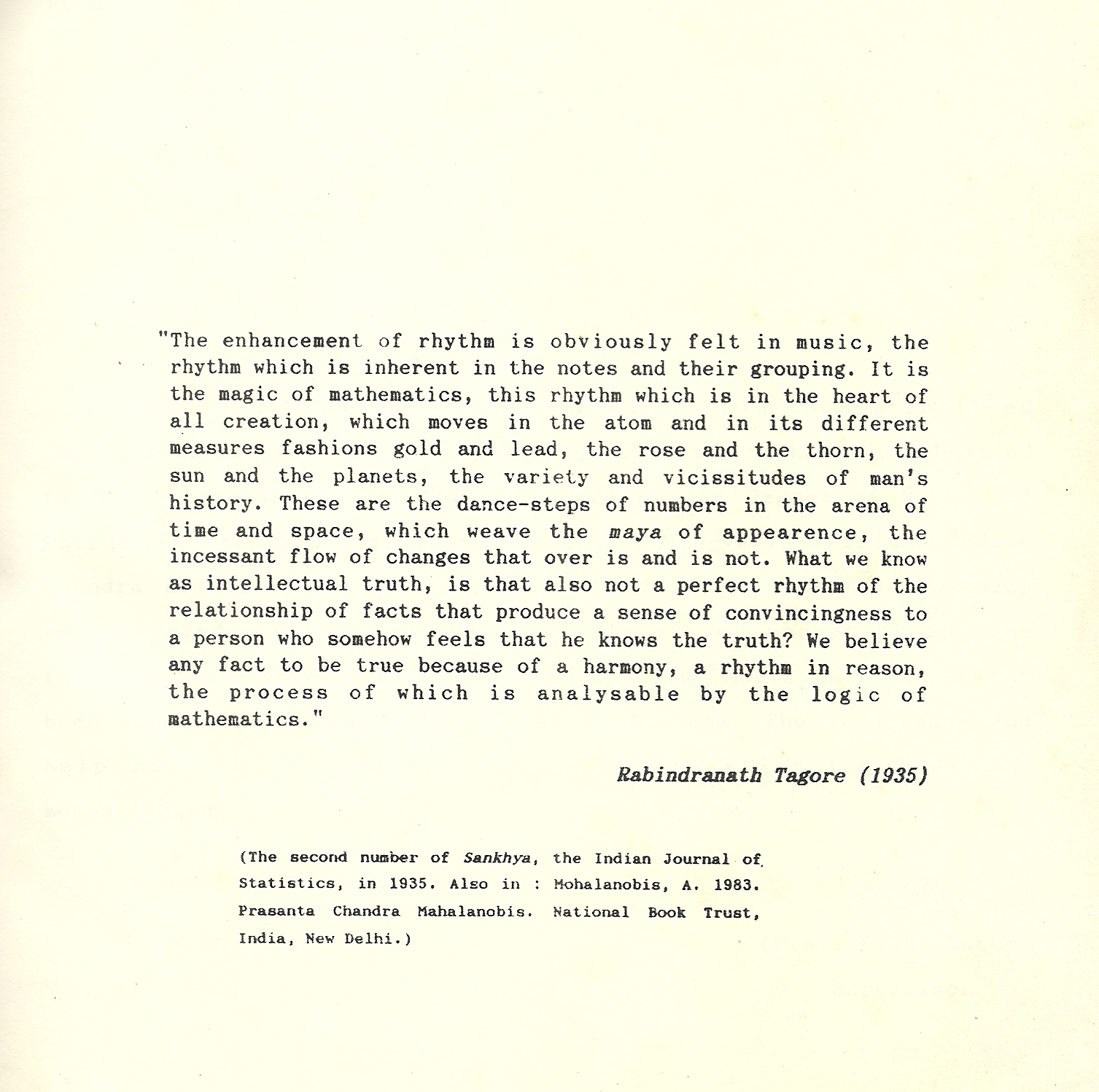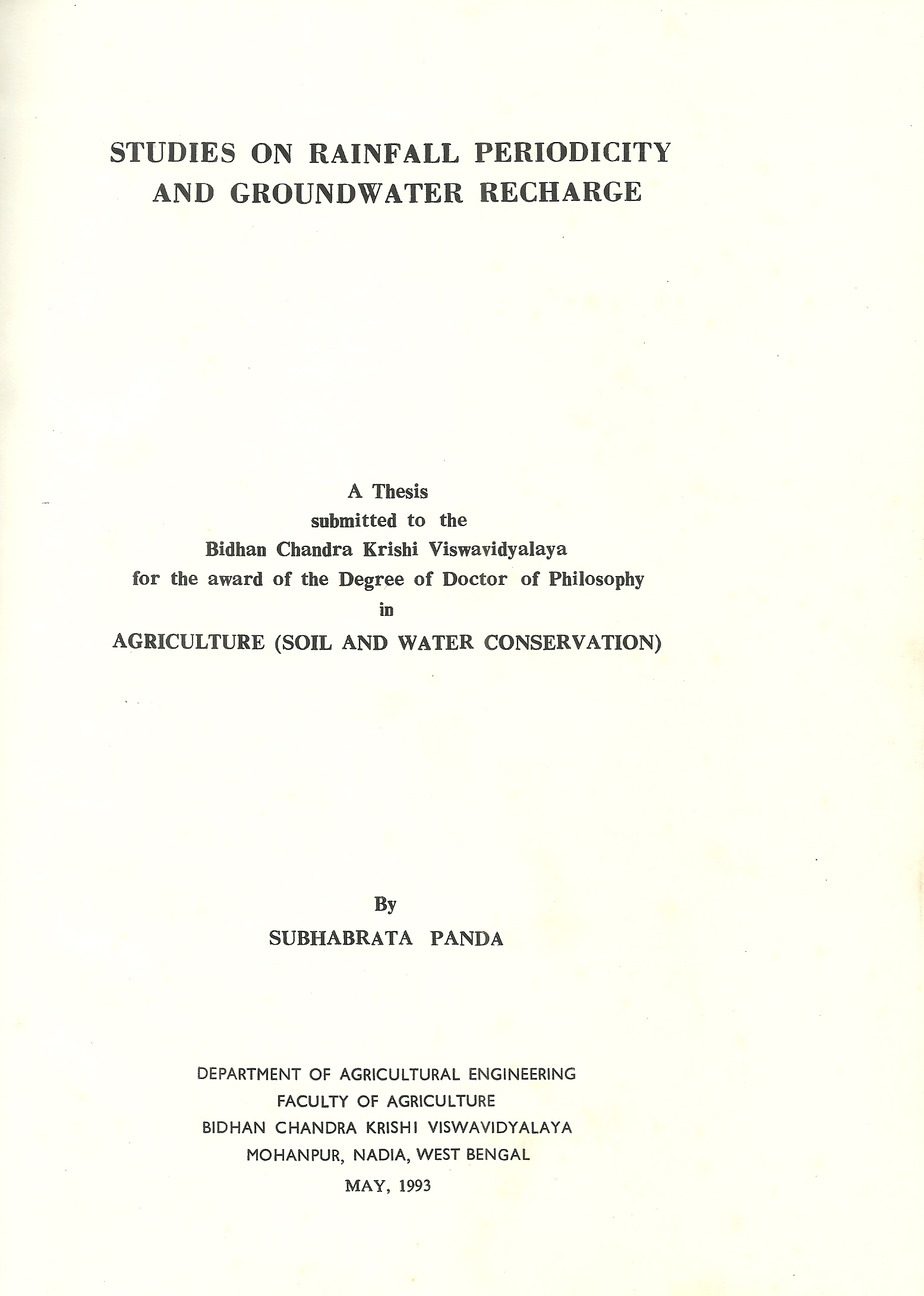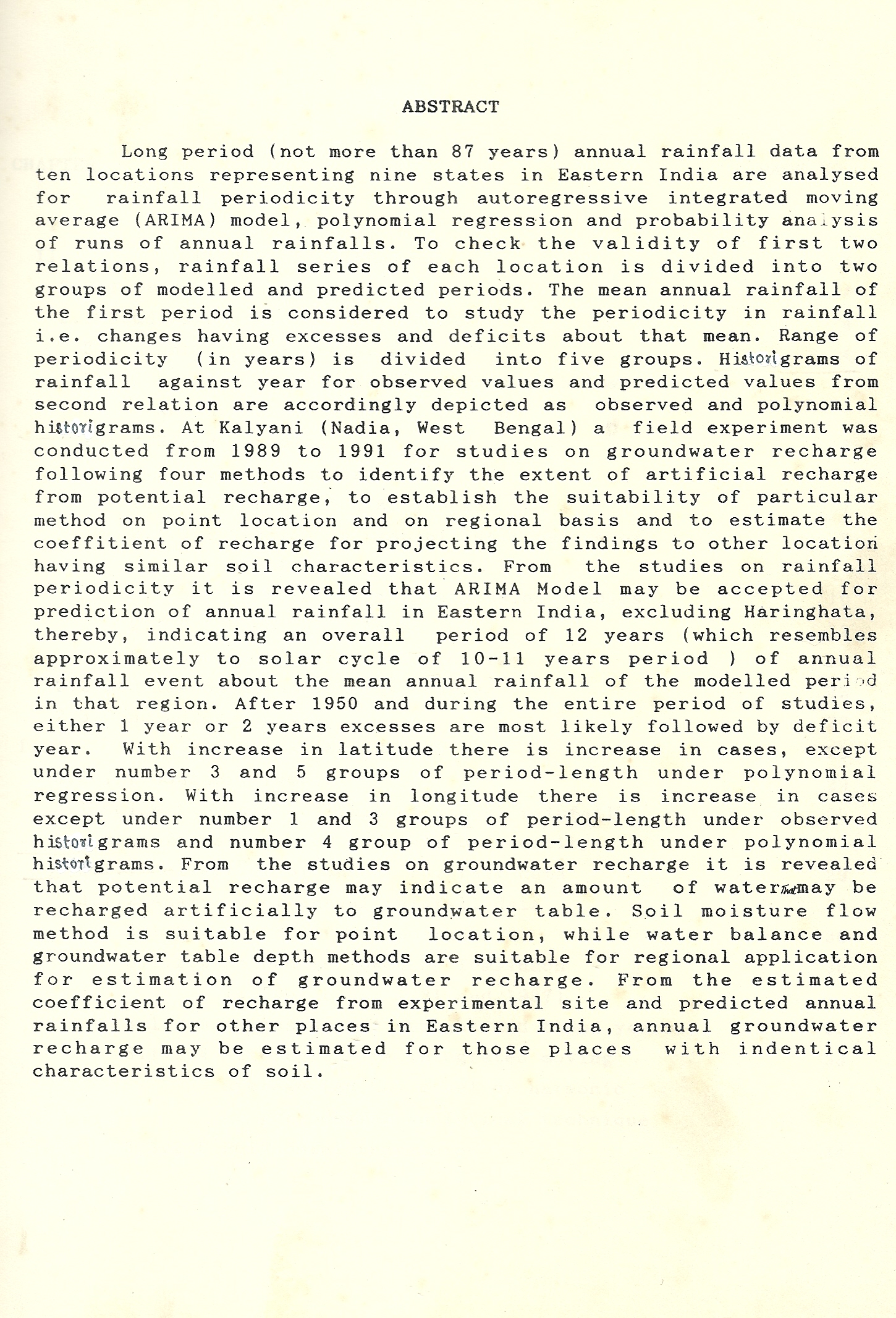Heat from the sun vis-à-vis evaporation and rainfall: Cause and effect
Sun is the source of all energies. Heat from the sun is the driving force in the earth’s hydrological cycle. It is due to the attraction of the sun that earth and the other planets move in their respective orbits. The amount of heat received from the sun depends upon
1) the length of the day and 2) the sun’s meridian altitude.
These two directly affect evaporation from earth’s surface. The earth is most heated when the daytime is longest and the reverse is the case when the day-time is shortest. Again when the sun’s rays strike the surface of the earth nearly perpendicularly a pencil of rays covers a smaller portion of the earth’s surface than it would cover when the rays come obliquely ; moreover in the latter case the rays have to pass through a greater extent of the atmosphere and, therefore, lose more heat. In spring and summer the sun is above the horizon for a longer period and the sun’s meridian altitude is greater than that in autumn and winter. So, the spring and the summer are warmer than he autumn and the winter.
In the southern hemisphere the same season occurs in the opposite time of the year. Thus, for example, December, the winter month in the northern hemisphere, is the summer month in the southern hemisphere.
These seasonal changes also vary from year to year. Thus, there would be annual variation in hydrological parameters like evaporation, rainfall, etc.
So, in search of a pattern exclusively in annual rainfall series is possible. Taking into account of other meteorological variables like temperature, as we often propose, may give more perfection in predicted result from the analyzed trend in annual rainfall pattern, if any.
So,while working on the periodicity in New Zealand-rainfall Tomlinson (1980) have justifiably commented that we are all constantly making judgments and decisions on the basis of incomplete information, but this is preferable to decisions based on no information at all. Statistical predictions of future rainfall should be seen in this light. Predictions of future conditions can be made for at least three reasons: to test hypothesis, for planning purposes and to attempt to avert catastrophes. In the case of future rainfalls, concern should be with the first and possibly the second of these objectives

CHAPTER – I
INTRODUCTION
1.1 Agriculture is mostly dependent on rainfall. If rainfall is adequate, good crops are expected. For proper crop planning, advance information regarding rainfall is very helpful. Accordingly, it is necessary to undertake investigations for evolving a proper methodology for forecasting annual rainfall.
1.2 The analysis of the periodicity of rainfall has evolved through human beings’ continuous strides over predicting any change in climate and has passed through speculation based on past experiences in the mythological period (e.g. . mythical Khana in India); postulations and hypotheses in the ancient historical period; and indexing, probability, correlation and regression studies and some trials on physically based models in the recent years. We are all constantly making judgments and decisions on the basis of incomplete information; but this is preferable to decisions based on no information at all. Statistical prediction of future rainfall should be seen in this light. Prediction of future condition can be made for at least three reasons: to test hypotheses; for planning purposes; and to attempt to avert catastrophes. In the case of future rainfall, concern should be with the first and possibly the second of these objectives.
1.3 The objective of this investigation is to examine the nature of changes of rainfall from year to year. Usually these changes are periodic, i.e. it does not usually follow any regular increasing or decreasing trend but with some type of cyclic changes having excesses and deficits.
1.4 Rainfall penetration through surface of the earth is one of the major factors for assessing hydrological balance for a particular area. This factor also helps to assess the groundwater resource through the estimation of recharge. There are many empirical formulae for estimation of this factor, but these are not universal in their application regarding their methodologies. So, the evaluation of a new method is needed considering basic flow characteristics of soil water such as hydraulic conductivity.
In the present studies an attempt is made for estimating rainfall recharge to groundwater from daily soil moisture flow through solution of Darcy’s equation and comparing this method with the potential recharge from continuous supply of water; recharge from water balance and recharge from groundwater table depth.
1.5 Irrigation water is one of the most vital inputs in agricultural production. So, the scientific utilization of this resource will hold the key to intensive sustainable agriculture in the ensuing years to come. For this purpose, the prediction of annual rainfall and formulation of new methods for more accurate estimation of rainfall recharge to groundwater are two most important factors for planning of water resources in any region leaving aside surface water resource.
1.6 With this background in view the present investigation has been taken up to meet the following objectives:
1. Prediction of annual rainfall in Eastern India –
i) modeling of annual rainfall series,
ii) identification of excess and deficit runs of annual rainfalls,
iii) effect of latitude and longitude on periodicity in annual rainfall.
2. Estimation of groundwater recharge from rainfall –
i) estimation of potential recharge,
ii) estimation of recharge from water balance,
iii) estimation of recharge from groundwater table depth,
iv) estimation of recharge from soil moisture flow,
v) comparative studies on four different methods for estimation of groundwater recharge,
vi) estimation of groundwater recharge from annual rainfalls,
vii) estimation of predicted annual groundwater recharge from predicted annual rainfall,
viii) examination of acceptability of predicted groundwater recharge from the estimated groundwater recharge at point location.
CHAPTER-II
REVIEW OF LITERATURE
2.0 Introductory remarks
It is not only the problem of coping with an immense worldwide problem of increasing demand of water that has to be faced but also equally daunting is the problem of producing a consistent body of hydrological theory that will be scientifically consistent and useful both for the planning of data measurements and the solution of problems in the real world (Doogee, 1988). Keeping this problem in view a review of literature is modeled on rainfall periodicity and groundwater recharge.
2.1 Studies on rainfall periodicity
2.1.1 Introductory remarks
The method of analysis of the periodicity of rainfall evolved through human beings’ continuous strides over predicting any changes in climate which passed through speculation based on past experiences in the mythological period ; postulations and hypotheses in the ancient historical periods; and indexing, probability, correlation and regression studies and some trials on physically based models in the recent years.
2.1.2 Prediction of rainfall during mythological and ancient historical periods
2.1.2.1 India, the land of Monsoon, has her tradition to study the rainfall from the time immemorial. During 1200 and 500 BC or 6000 and 4000 BC in Rg-Veda, the oldest literary works of the Aryans settled on coming to India, there is the description of what could be the monsoon rains in the north-west India though the Word Monsoon was coined much later and that information was pointed out by an Indian scholar, M.V.Unakar in his treatise nearly fifty five years ago. There is also mention of the return of a rain-time, the rainy season of the year. The fact that there was period when it rained heavily every year was observed by the early Aryan settlers in India (Das, 1988).
2.1.2.2 By the fourth century BC during the reign of the Maurya in India in the book of Kautilya Arthasastra, there is details for measuring rains and the reference of using rain gauge and there was attempt of forecasting of such rainfall by observing the position, motion and pregnancy (garbhadhana) of Jupiter; the rise, set and motion of Venus and the natural and unnatural aspect of the Sun (Shastri,1919and 1923; and Chattopadhyay,1982).
2.1.2.3 During the contemporary period of Kautilya, in a comprehensive text on agricultural science Kasyapamuni Kathita Kasyapiya Krishi Sukti assigned to Muni Kasyapa there is a mention about the desirability of waiting for the Monsoon to take up agricultural operations (Raychawdhuri and Kaw, 1964; and Ashok Raj, 1979) and according to Wilson (1835) and Garrett (1871) Kasyapa lived during the fourth century BC in India.
2.1.2.4 In the Christian Bible there is mention of a period of seven good years followed by seven years of famine in Egypt (Borley, 1989).
2.1.2.5 In the later periods there occur descriptions of the Monsoon in the early history of countries which had a maritime interest over the Arabian Sea and the neighbouring parts of the Indian Ocean. There occurs a description of the Monsoon in the Periplus of the Erythrean Sea written about 60 AD by an unknown Greek sailor. A periplus is a navigators’ pilot book, and Erythrean Sea was the name given by the ancient Greeks to the Red Sea, the Persian Gulf and the Arabian Sea (Das,1988).
2.1.2.6 Around 400 AD Fa Hsien, a Buddhist scholar visited India from China, referred to the winter Monsoon along the east coast of India in his writings, Record of the Buddhist Kingdoms (Das, 1988).
2.1.2.7 In India Kalidasa, a contemporary of Fa Hsien, perhaps most beautifully described the appearance of monsoon clouds in his Sanskrit classic, Meghdootam around fourth century AD. In his book Kalidasa described the arrival of the monsoon at Ujjain (in Madhya Pradesh State) on the first day of Asadha (15 June) which is surprisingly similar with the present arrival of monsoon rains over that part of India (Das, 1988) and considering the changes in the climate this fact may lead to a postulation on the periodic nature of rainfall.
2.1.2.8 There is a book extant called Krsi-Parasara bearing on the subject of agriculture and there are the sayings of the mythical Khana full of practical suggestions that are found useful even today (Eder, 1964, 1966 and 1970; Rama Raju, 1976; Ali, 1979; Majumdar, 1982). Krsi-Parasara is of uncertain date but was composed of not later than fifth century AD. A translation of the Bengali edition of that book has been published by the Rothamstad Experimental Station in the form of a bulletin (Chattopadhyay, 1982). The time of Khana was not more than four hundred years ago, but there is conspicuous similarity among some of her works with those of Varahamihira of nearly one thousand and five hundred years ago (Vidyaratna,1900; Kar, 1929; Bandyopadhyay,1967 and 1973;and Chattopadhyay, 1982).
2.1.2.9 Near about the tenth century AD, Al Masu’di, an Arabian geographer from Baghdad, gave accounts of the reversal of ocean currents over the Indian Ocean in his book, Meadows of gold and mines of gems(Das,1988).
2.1.3 Recent studies
2.1.3.1 In the wake of predicting any trends in the climatic change the studies in the recent years evolves the methods like formulation of indexes, studies on probability of occurrence, studies on correlation and regression of rainfall over other climatic factors, physically based models and the studies on periodicity.
2.1.3.2 Formulation of indexes
2.1.3.2.1 The occurrence of drought and flood has a tendency to create an impression regarding the setting up of a trend in the rainfall of a region. The climate of any place is the composite weather condition by averaging the atmospheric elements like rainfall over a long period of time say thirty years or more. An usual event like flood or drought is very unlikely to change such values (Das, 1988) like drought index (Kalyanasundaram and Ramasastry, 1970), CAFEC (Climatically Appropriate For Existing Condition) precipitation (George et al.,1973), climatic crop growth indices (Das,1976), or effective rainfall (Cocheme and Franquin, 1967; Virmani, 1975; Morris and Zandstra, 1978; Ashok Raj,1979; Stern et al., 1981 and 1982), precipitation concentration index (PCI) over Asia and regional division by Sato et al. (1985) and assessment of agricultural drought from soil moisture deficit by George and Ramachandran (1970) and areal extent of south-west monsoon droughts in India by George et al. (1975).
2.1.3.2.2 Mindling (1944) studied the occurrence and duration of dry periods, using a total of one inch of precipitation as the criterion for the end of a drought. The hydrological excess, flood and droughts were identified following Oliver’s precipitation concentration index using triad rainfall for the season June through September for the period 1901-80 of 360 selected stations (Singh et al., 1988) and the onset of monsoon rainfall patterns in India was studied by Sreekesh and Sivasami (1988).
2.1.3.3 Studies on probabilistic nature of rainfall
2.1.3.3.1 Studies on the estimates of probable rainfall were done by Thom (1966), Engman and Hershfield (1969), Diskin (1970), Raman et al., (1970), Battan and Green (1971), Duckstein et al. (1973), Doorenbos and Pruitt (1975), Hanson et al. (1980), Vines and Tomlinson (1980), Hanson (1982), French (1983), Tung (1983), Osborn (1984, 1987), Woolhiser et al.(1985), Goel (1987), Sivaramakrishnan and Sridharan (1988) and others.
2.1.3.3.2 Hershfield and Wilson (1960) studied on the comparison of extreme rainfall depths from tropical and subtropical storms; Huff and Changnon (1963) published an elaborate study of drought frequency in Illinois, which centered attention on the frequency and duration of periods of drought weather; maximum possible rainfall at a station was studied by Ranga Rao (1967); distribution function for seasonal and annual rainfall over India was studied by Mooley and Rao (1968); Jenkinson (1969) studied on the estimation of maximum floods; forecasting of heavy rain was done by Raman et al. (1970); rainfall patterns over India and adjacent seas were studied by Ananthakrishnan and Pathan (1971); Kazman (1972) elaborated the importance of preparing the maps showing the frequency of droughts to determine the need for a supplemental irrigation in humid areas and the need for large reservoirs to supply adequate water to concentrations of people and industry and for crop production during drought periods; Victor and Sastry (1979) studied the dry spell probability by Markov Chain Model and its applications to crop development stages; NERC (1975) published report on flood studies; Vanniasingam and Shaw (1978) studied on rainfall depth-duration-frequency for Sri Lanka; short period fluctuations of New Zealand rainfall were studied by Tomlinson (1976); the possibility of using the non-seasonal rainfall as a parameter in forecasting the nature of annual rainfall was found out by Sivaramkrishnan (1983); Goel (1984) studied on probable rainfall for integrated planning; fluctuations in All-India summer monsoon rainfall during 1871-1978 were studied by Kooley and Parthasarathy (1984); Sreedharan and James (1988, 1990) studied on the rainfall frequency analysis for western ghats region and the Periyar basin of Kerala in India; probability analysis of annual rainfall of Orissa was done to study the probability of occurrence for effective water-harvesting and water conservation structures by Sharma et al. (1988); Dhar and Nandargi (1989) studied the severe rainstorms of contiguous Indian states; Rao (1990 a, b) studied the loss rates for application to severe rainfall storms and on temporal distribution of design storm rainfall.
2.1.3.4 Correlation and regression studies
2.1.3.4.1 A good number of attempts have been contributed to focus on the climatic trend through studies on correlation and regression of rainfall over other climatic factors.
2.1.3.4.2 As for example, correlation approach in seasonal variation in climate (Walker, 1908); Upper air correlation (Mahalanobis, 1922); correlation and variation of normal rainfall for July, August and September in North Bengal (Mahalanobis, 1923 a, b); statistical studies in meteorology (Mahalanobis, 1924); rainfall in relation to floods in north Bengal (Mahalanobis, 1926 a, b) ; correlation between the height of Brahmani at Jenapore in Orissa and the rainfall in the catchment area (Mahalanobis, 1933); precipitation and percentage of runoff in the Mahanadi in Orissa (Mahalanobis and Chakravarti, 1933); correlation of rainfall during rain storms in the Mahanadi catchment (Mahalanobis and Nag, 1933); exact test of association between the occurrence of thunderstorm and upper air ionization (Mahalanobis and Bose, 1937 a, b); seasonal forecasting in India (Savur, 1933); characteristic feature of rainstorms and river floods in Orissa (Mahalanobis, 1940 a, b); regional variation of rainfall in Britain (Reynolds, 1953; Gregory, 1956) ; systematic variations in the annual rainfall over certain parts of India (Pramanik and Jagannathan, 1953); fluctuations of wet and dry years analysed by serial correlation (Friedman, 1957); prediction of long-continuing drought in south and south-east Texas ( Yevjevich, 1964); secular variations of regional rainfall over India (Parthasarathi and Dhar, 1974); effects of urbanisation on precipitation (Rao and Rao, 1983); hydroclimatic fluctuations of the upper Narmada catchment and its association with break-monsoon days over India (Singh et al., 1988); the seasonality of monsoon rainfall distribution in Bangladesh for its association with the seasonal changes in soil moisture, surface flow and groundwater level to determine the irrigation requirement as well as capacity during the drier months and to tune the crop calender with the arrival and departure of monsoon (Shamsuddin and Alas, 1988); diagnostic study of south-west monsoon (Singh and Thorat, 1988); rainfall and flood study of 1989 monsoon season over contiguous India (Dhar and Nandargi, 1990).
——to be continued


